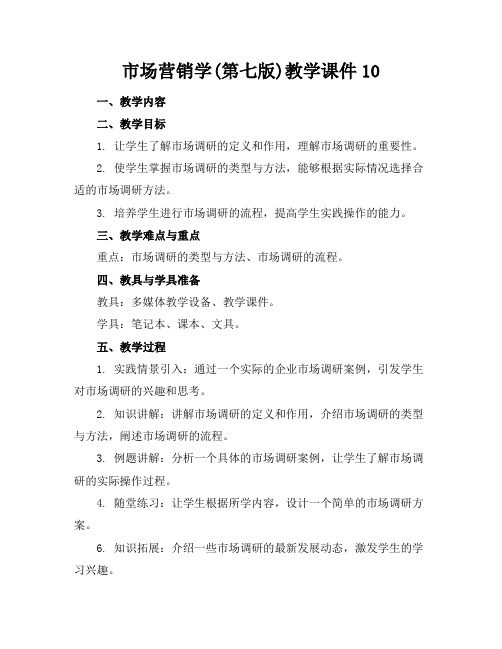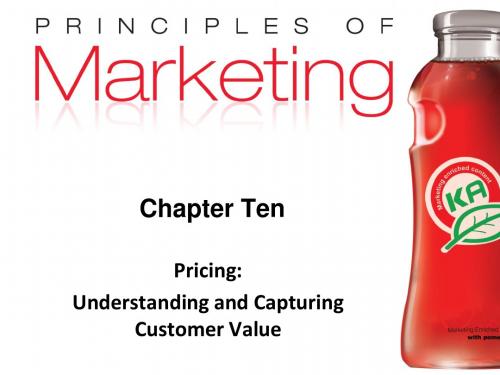市场营销学英文版最新版教学课件第10章
高职《市场营销学》完整教学课件(2024)

个人因素
包括年龄、生命周期阶段、职业、经济状况等, 决定消费者的购买能力和需求偏好。
ABCD
2024/1/29
社会因素
包括家庭、参照群体和社会角色等,对消费者购 买决策具有直接影响。
心理因素
包括动机、感知、学习和信念等,影响消费者对 产品的认知和评价。
15
04 目标市场战略制定
2024/1/29
16
04
03
2024/1/29
13
消费者购买行为类型及过程
购买行为类型
包括复杂型购买行为、协调型购买行 为、变换型购买行为和习惯型购买行 为。
购买过程
包括需求认知、信息收集、方案评价 、购买决策和购后行为等阶段。
2024/1/29
14
影响消费者购买行为的因素
文化因素
包括文化、亚文化和社会阶层等,对消费者价值 观、审美和购买习惯产生深远影响。
2024/1/29
将多种产品组合在一起销售,以整体价格优 势吸引消费者购买。这种策略适用于提高销 售额和市场份额。
27
07 分销渠道设计与管理
2024/1/29
28
分销渠道类型及功能
直接渠道
生产商直接向最终用户销售产品或服 务,减少中间环节,降低流通成本。
间接渠道
生产商通过中间商向最终用户销售产 品或服务,利用中间商的资源、经验 和网络优势,扩大销售范围。
22
新产品开发流程管理
新产品开发流程
包括创意产生、概念形 成、产品开发、市场测 试和上市推广五个阶段 。
2024/1/29
创意来源与评估
鼓励企业内部员工和外 部合作伙伴提出创新想 法,并进行评估筛选。
新产品开发团队组建
市场营销英文课件(PPT)

A company can add new products through acquisition of other companies.
第十六页,共三十八页。
第十七页,共三十八页。
第十页,共三十八页。
After international marketers position their products, they need to develop the product strategies according to the position.
1. International Product Mix Strategy The international product mix consists of all the
第二页,共三十八页。
International Product and Brand Strategy
第三页,共三十八页。
The question of Diversification v.s Standardization.
For most products, adaption to local preference is a must. But adaption to every local market may cost a company too much.
The products include the tangible products and intangible services or a combination of them.
第五页,共三十八页。
2.1 Consumer Products
2024年度《市场营销学》完整ppt课件

2024/3/23
02
处理危机事件
及时应对和处理危机事件,减少负 面影响并恢复品牌形象。
社会责任履行
积极履行社会责任,关注环保、公 益等问题,提升品牌美誉度。
04
27
07
品牌建设与管理
2024/3/23
28
品牌定位与品牌形象塑造
品牌定位
确定品牌在目标市场中的独特位置,与竞争对手区分开来,满足消 费者特定需求。
销售观念阶段
企业开始重视销售和推广,以 销售为中心。
市场营销观念阶段
企业开始以客户为中心,关注 市场需求和客户满意度。
2024/3/23
5
市场营销的核心概念
需要、欲望和需求
产品
价值、成本和满意
交换和交易
关系和网络
需要是基本的人类要求, 欲望是特定满足需要的具 体物品,需求是具备购买 力和购买欲望的欲望。
6
关系是企业和客户之间建 立的长期互动和合作,网 络是企业与客户、供应商、 合作伙伴等建立的复杂联 系和互动。
02
市场分析
2024/3/23
7
消费者行为分析
消费者需求识别
消费者心理与行为特征
通过市场调研和数据分析,识别消费 者的真实需求和潜在需求。
研究消费者的心理特征和行为习惯, 以便更好地满足其需求。
社交媒体营销
01
社交媒体营销 概述
02
社交媒体平台 选择
2024/3/23
社交媒体内容 策划与传播
03
04
社交媒体数据 分析与优化
34
内容营销
2024/3/23
01
内容营销概念及重要性
02
内容创作技巧与方法
国际营销英文版最新版教学课件unit10

• Nations must give up part of sovereignty
• Advantages of union must be clear-cut and significant • Benefits must greatly outweigh the disadvantages
• Distance across time zones most important
• Trade tends to travel more easily in north-south directions than it did in ancient times
• Issues of legal and illegal immigration important
Chapter 10
Europe, Africa, and the Middle East
Learning Objectives
10-1 The reasons for economic union
10-2 Patterns of international cooperation
10-3 The evolution of the European Union
1. Regional Cooperation Groups 2. Free Trade Area 3. Customs Union 4. Common Market 5. Political Union
Patterns of Multinational Cooperation 2 of 6
市场营销第一章(英文)(ppt文档)

marketing intermediaries
Final consumers
2.Designing a consumer-driven marketing strategy
• Selecting customers to serve
Marketing management: the art and science of choosing target markets and building profitable relationships with them. demarketing: marketing to reduce demand temporarilly or permanently; the aim is not destroy demand but only to reduce or shift it.
4.Build profitable relationships and creat customer delight
5.Capture value from customers to create profits and customer qulity
1.Understand the marketplace and consumer needs and wants Five core marketplace Concepts: P5
The Marketing Concept The Societal Marketing Concept
(1)p9 The Production Concept
• The philosophy that consumers will favor products that are available and highly affordable and that management should therefore focus on improving production and distribution efficiency
市场营销学英文版最新版教学ppt课件第11章

Price Decision• Price policy must fit the retailers’– Target market and positioning– Product and service assortment– Competition– Economic factors• Retailers practice either– Everyday low pricing (EDLP)– High-low pricing
Marketing: An IntroductionThirteenth Edition
Chapter 11Retailing and Wholesaling
Learning Objectives (1 of 2)11-1. Explain the role of retailers in the distribution channel and describe the major types of retailers. 11-2. Describe the major retailer marketing decisions. 11-3. Discuss the major trends and developments in retailing.11-4. Explain the major types of wholesalers and their marketing decisions.
Major Types of Retail Organizations
Learning Objective 11-1 Summary• Retailing - selling goods or services directly to final consumers• Shopper marketing - turning shoppers into buyers• Omni-channel retailing - integrates in-store, online, and mobile shopping• Retailers classified by amount of service, product line sold, and relative prices• Corporate and contractual retail organizations
市场营销学英文课件Ch09精品教案课件讲义下载后可编辑

Marketing Strategy for Unsought Goods
Use aggressive personal selling Use very persuasive advertising Point of purchase advertising important May have limited number of outlets
Product Mix for Kraft General Foods
Breakfast Food
Baked Goods
• Alpha-bits •Country Kitchen Syrup •Fruit & Fiber •Grape-nuts •honeycomb •Log Cabin Syrup •Pebbbles •Post 40% Bran
Marketing Strategy for Shopping Goods
Selective distribution Can be placed in back of store Stress brand differences in advertising and personal selling, packaging
Classification Figure
Willingness to Expend Effort for Purchase
Unsought Goods
Convenience Products:
Very little or minimum effort
Shopping Products:
Considerable amount of effort
Satisfied & Switching Cost
市场营销学英文版最新版教学课件第11章

Learning Objective 11-3
Discuss the major trends and developments in retailing.
Segmentation, Targeting, Differentiation, and Positioning Decisions (2 of 2)
Which Wich Superior Sandwiches succeeds by positioning itself strongly away from larger competitors.
First Stop: Walmart The World’s Largest
Retailer-the World’s Largest Company
“Save money. Live better.” Says Walmart’s CEO, “We’re obsessed with delivering value to customers.”
• Omni-channel retailing: Creating a seam-less crosschannel buying experience that integrates in-store, online, and mobile shopping
Types of Retailers
– Everyday low pricing (EDLP) – High-low pricing
Promotion Decision
• Retailers use various combinations of the five promotion tools:
– Advertising – Personal selling – Sales promotion – Public relations (PR) – Direct and social media marketing
市场营销学(第七版)教学课件10

第一节 产品与产品分类 第二节 产品组合 第三节 产品生命周期 第四节 包装与包装策略 第五节 新产品开发
1
第一节 产品与产品组合
一、产品及产品整体概念 二、产品的分类
2
一、产品及产品整体概念
产品 一般是指通过交换提供给市场的,能满足消费者
或用户某一需要和欲望的任何有形物品和无形服 务。
D 35
(四)衰退期的特点与营销策略
2、衰退期的营销策略 • 集中策略 • 维持策略 • 榨取策略
36
第四节 包装与包装策略
一、包装及其分类 二、包装在营销中的作用 三、包装设计与要求 四、装潢 五、包装策略
37
一、包装及其分类
包装
• 为产品设计、制作包装物的活动过程。 • 包装物
按包 首要包装
销售量增长很快;
3 产品已定型,技术工艺比较
成熟;
5 市场价格趋于下降;
7 单位生产成本迅速下降,
企业利润迅速上升。
2 大批竞争者加入,
市场竞争加剧;
4 建立了比较理想的营销渠道;
6 企业的促销费用水平基本稳
定或略有提高,但占销售额 的比率下降;
31
2、成长期的营销策略
A
根据用户需求和其他市场 信息,不断提高产品质量, 努力发展产品的新款式、 新型号,增加产品的新用 途。
• 优化产品组合的过程,通常是分析、评价和调整现行产品 组合的过程。
1.产品线销售额和利润分析
2.产品项目市场地位分析
19
三、产品组合的调整
(一)扩大产品组合
⑴开拓产品组合的宽度
•增加产品线,扩展经营领域,实行多 样化经营,分散企业投资风险;
⑵增加产品组合的长度
市场营销英文版科特勒PPT课件

Copyright © 2012 Pearson Education, Inc. Publishing as Prentice Hall
Chapter 4- slide 7
Assessing Marketing Information Needs
Characteristics of a Good MIS
Copyright © 2012 Pearson Education, Inc. Publishing as Prentice Hall
Chapter 4- slide 13
Consider a local business near campus. . .
How would they conduct exploratory research?
WhatDmeigvhtetlhoeypwinangt tMo fiandrkoeuttiinndgesIcnripftoivremresaetairochn?
What relationships might they explore in causal research?
Marketing Research Defining the Problem and Research Objectives
Internal Data
Internal databases are electronic collections of consumer and market information obtained from data sources within the company network
• Cookies
Copyright © 2012 Pearson Education, Inc. Publishing as Prentice Hall
市场营销学(第七版)教学课件10

市场营销学(第七版)教学课件10一、教学内容二、教学目标1. 让学生了解市场调研的定义和作用,理解市场调研的重要性。
2. 使学生掌握市场调研的类型与方法,能够根据实际情况选择合适的市场调研方法。
3. 培养学生进行市场调研的流程,提高学生实践操作的能力。
三、教学难点与重点重点:市场调研的类型与方法、市场调研的流程。
四、教具与学具准备教具:多媒体教学设备、教学课件。
学具:笔记本、课本、文具。
五、教学过程1. 实践情景引入:通过一个实际的企业市场调研案例,引发学生对市场调研的兴趣和思考。
2. 知识讲解:讲解市场调研的定义和作用,介绍市场调研的类型与方法,阐述市场调研的流程。
3. 例题讲解:分析一个具体的市场调研案例,让学生了解市场调研的实际操作过程。
4. 随堂练习:让学生根据所学内容,设计一个简单的市场调研方案。
6. 知识拓展:介绍一些市场调研的最新发展动态,激发学生的学习兴趣。
六、板书设计板书设计如下:市场调研定义和作用类型与方法流程信息处理与分析七、作业设计1. 作业题目:设计一个针对大学生消费行为的市场调研方案。
答案:包括调研目标、调研对象、调研方法、调研流程等内容。
答案:包括调研背景、调研目的、调研方法、调研结果、结论和建议等内容。
八、课后反思及拓展延伸拓展延伸:鼓励学生参加市场调研相关的实践活动,提高学生的实际操作能力。
重点和难点解析一、教学内容二、教学目标1. 让学生了解市场调研的定义和作用,理解市场调研的重要性。
2. 使学生掌握市场调研的类型与方法,能够根据实际情况选择合适的市场调研方法。
3. 培养学生进行市场调研的流程,提高学生实践操作的能力。
三、教学难点与重点重点:市场调研的类型与方法、市场调研的流程。
四、教具与学具准备教具:多媒体教学设备、教学课件。
学具:笔记本、课本、文具。
五、教学过程重点和难点解析1. 实践情景引入:通过一个实际的企业市场调研案例,引发学生对市场调研的兴趣和思考。
市场营销学英文版最新版教学课件第10章

Figure 10.2 - Consumer and Business Marketing Channels
– Direct marketing channel: No intermediary levels – Indirect marketing channels: One or more
intermediary levels
Number of Channel Levels (2 of 2)
• Types of flows that connect the institutions in the channel:
First Stop: Uber Radically Reshaping Urban Transportation
Uber lets passengers hail the nearest cab from any location using its smartphone app.
Learning Objective 10-1
Value Delivery Network (2 of 2)
Pepsi manages a huge network to create customer value and establish the brand’s positioning.
Marketing Channels (Distribution Channels)
• Horizontal and vertical channel conflict • Conventional distribution system, vertical
市场营销讲稿(英文版)(ppt 36页)

l
Journals:
Journal of Marketing
Marketing News
Harvard Business Review
International Journal of Research in Marketing
Journal of Advertising 《营销导刊》 《销售与市场》 《市场营销》(人大复印资料)
•What is marketing?
Core Concepts
Needs, wants, and demands
Products
Markets
Core Marketing Concepts
Value, satisfaction, and quality Exchange, transactions, and relationships
consists of all activities that bring buyers and sellers together
Analysis, Plan, implement, control
Marketing mix(4ps)
Managing Products and Services(Product) Distributing Products and Services(Place) Pricing Products and Services(Price) Promotion Products and
英文国际市场营销chapter-10ppt课件

•onsumer and business-tobusiness markets
Quality
• Intense global competition is placing new emphasis on manufacturing quality products
• Quality, as a competitive tool, is the deciding factor in world markets
Quality can be defined on two dimensions: (1) market-perceived quality and (2) performance quality
• Green marketing is a term used to identify concern with the environmental consequences of a variety of marketing activities
• The designation that a product is “environmentally friendly” is voluntary, and environmental success depends on the consumer selecting the eco-friendly product
to measure satisfaction across a wide variety of consumer products and services
Physical or Mandatory Requirements and Adaptation
2024全新市场营销学ppt课件(2024)

2024/1/30
25
数字化时代促销创新
2024/1/30
社交媒体营销
利用社交媒体平台,与目标受众进行互动和交流,提高品牌知名 度和用户黏性。
大数据分析与应用
运用大数据技术分析消费者行为和需求,制定个性化的促销策略。
线上线下融合
结合线上和线下渠道,打造全方位的购物体验,提高消费者满意度 和忠诚度。
20
物流管理在渠道中作用
2024/1/30
物流成本控制
01
通过有效的物流管理,降低产品在渠道流通过程中的成本,提
高渠道整体利润水平。
物流效率提升
02
优化物流配送网络,提高物流配送速度和准确性,满足消费者
对产品时效性和便捷性的需求。
物流信息服务
03
利用信息技术手段,实现物流信息的实时共享和传递,提高渠
市场评估法
通过市场调查和消费者研 究来评估品牌在市场上的 表现和价值。
综合评估法
综合考虑财务和市场因素 ,以及其他非财务因素( 如品牌忠诚度、品牌知名 度等)来评估品牌价值。
2024/1/30
14
2024/1/30
04
CATALOGUE
价格策略与竞争分析
15
定价方法及适用场景
1 2
成本导向定价法
缩减产品组合
产品线延伸
集中力量经营获利较多的产品线和产品项 目。
在原有产品线内增加高档或低档产品,以满 足不同消费者需求。
2024/1/30
12
品牌定位与传播途径
01
品牌定位
指品牌在消费者心中的位置,与竞 争品牌相比的优势和独特性。
公关活动
利用新闻发布会、赞助活动、社会 公益活动等提高品牌知名度。
市场营销学英文版最新版教学课件第1章

• Form taken by human needs when shaped by culture and individual personality
Demands
• Human wants that are backed by buying power
Customer Needs, Wants, and Demands (2 of 2)
Staying close to customers: Target’s energetic new CEO
Market Offerings
• Products, services, information or experiences
– Offered to satisfy a need or want
Understanding the Marketplace and Customer Needs
• Five core customer and marketplace concepts:
– Needs, wants, and demands – Market offerings – Value and satisfaction – Exchanges and relationships – Markets
– Strong relationships are built by consistently delivering superior customer value.
Markets
• All actual and potential buyers of a product • Sellers and Consumers market • Customer-managed relationships
市场营销学ppt第10章

Chapter 10- slide 8
Factors to Consider When Setting Prices
Customer Perceptions of Value
Value-based pricing Good-value pricing Value-added pricing
Copyright © 2010 Pearson Education, Inc.
Copyright © 2010 Pearson Education, Inc.
Chapter 10- slide 10
Factors to Consider When Setting Prices
Customer Perceptions of Value
Everyday low pricing (EDLP) involves charging a constant everyday low price with few or no temporary price discounts High-low pricing involves charging higher prices on an everyday basis but running frequent promotions to lower prices temporarily on selected items
Topic Outline
• What Is a Price? • Customer Perceptions of Value • Company and Product Costs • Other Internal and External Considerations Affecting Price Decisions
- 1、下载文档前请自行甄别文档内容的完整性,平台不提供额外的编辑、内容补充、找答案等附加服务。
- 2、"仅部分预览"的文档,不可在线预览部分如存在完整性等问题,可反馈申请退款(可完整预览的文档不适用该条件!)。
- 3、如文档侵犯您的权益,请联系客服反馈,我们会尽快为您处理(人工客服工作时间:9:00-18:30)。
• Intermediaries bridge the major time, place, and possession gaps that separate goods and services from users.
– Transaction, information, communication, matching, negotiation, physical distribution, financing, and risk taking
Learning Objective 10-2
Discuss how channel members interact and how they organize to perform the work of the channel.
Learning Objective 10-1 Summary
• Value delivery network
• Intermediaries form the marketing channel (or distribution channel)
• Marketing channel functions:
Figure 10.1 - How a Distributor Reduces the Number of Channel Transactions
How Channel Members Add Value
• Intermediaries create greater efficiency in making goods available to target markets.
• Physical distribution • Financing • Risk taking
Number of Channel Levels (1 of 2)
• Channel level: A layer of intermediaries that performs work in bringing the product and its ownership closer to the final buyer
Channel Behavior (1 of 2)
• Channel conflict: Disagreements among marketing channel members on goals, roles, and rewards
– Horizontal conflict occurs among firms at the same level of the channel.
Figure 10.3 Comparison of Conventional Distribution Channel with Vertical Marketing System
Vertical Marketing Systems
• A vertical marketing system (VMS) consists of producers, wholesalers, and retailers acting as a unified system.
• Downstream partners serve as distribution channels that link the firm and its customers.
Value Delivery Network (1 of 2)
A network composed of the company, suppliers, distributors, and, ultimately, customers who partner with each other to improve the performance of the entire system in delivering customer value
Disintermediation (2 of 2)
Spotify is rapidly disintermediating both traditional music stores and music download services.
Learning Objective 10-2 Summary
• Interdependent organizations that help make a product or service available for use or consumption
• Channel decisions
– Affect every other marketing decision – Can lead to competitive advantage – May involve long-term commitments to other firms
Learning Objectives (2 of 4)
10-4. Explain how companies select, motivate, and evaluate channel members.
10-5. Discuss the nature and importance of marketing logistics and integrated supply chain management.
• There are three types of VMSs:
– Corporate – Contractual – Administered
Horizontal Marketing System (1 of 2)
Two or more companies at one level join together to follow a new marketing opportunity.
– Harder to control – Generates conflict
Figure 10.4 – Multichannel Distribution System
Disintermediation (1 of 2)
• Occurs when product or service producers cut out marketing channel intermediaries or when radically new types of channel intermediaries displace traditional ones
– Vertical conflict occurs between different levels of the same channel.
Channel Behavior (2 of 2)
“There’s a huge connection” between franchisee satisfaction and customer service.
First Stop: Uber Radically Reshaping Urban Transportation
Uber lets passengers hail the nearest cab from any location using its smartphone app.
Learning Objective 10-1
Key Functions Performed by Channel Members
Help to complete transactions
• Information • Promotion • Contact • Matching • Negotiation
Help to fulfill the completed transactions
10-2. Discuss how channel members interact and how they organize to perform the work of the channel.
10-3. Identify the major channel alternatives open to a company.
– Direct marketing channel: No intermediary levels – Indirect marketing channels: One or more
intermediary levels
Number of Channel Levels (2 of 2)
• Types of flows that connect the institutions in the channel:
Horizontal Marketing System (2 of 2)
General Mills and Nestlé operate a joint venture—Cereal Partners Worldwide.
Multichannel Distribution Systems
• A single firm sets up two or more marketing channels to reach customer segments.
Value Delivery Network (2 of 2)
Pepsi manages a huge network to create customer value and establish the brand’s positioning.
Marketing Channels (Distribution Channels)
• Horizontal and vertical channel conflict • Conventional distribution system, vertical
